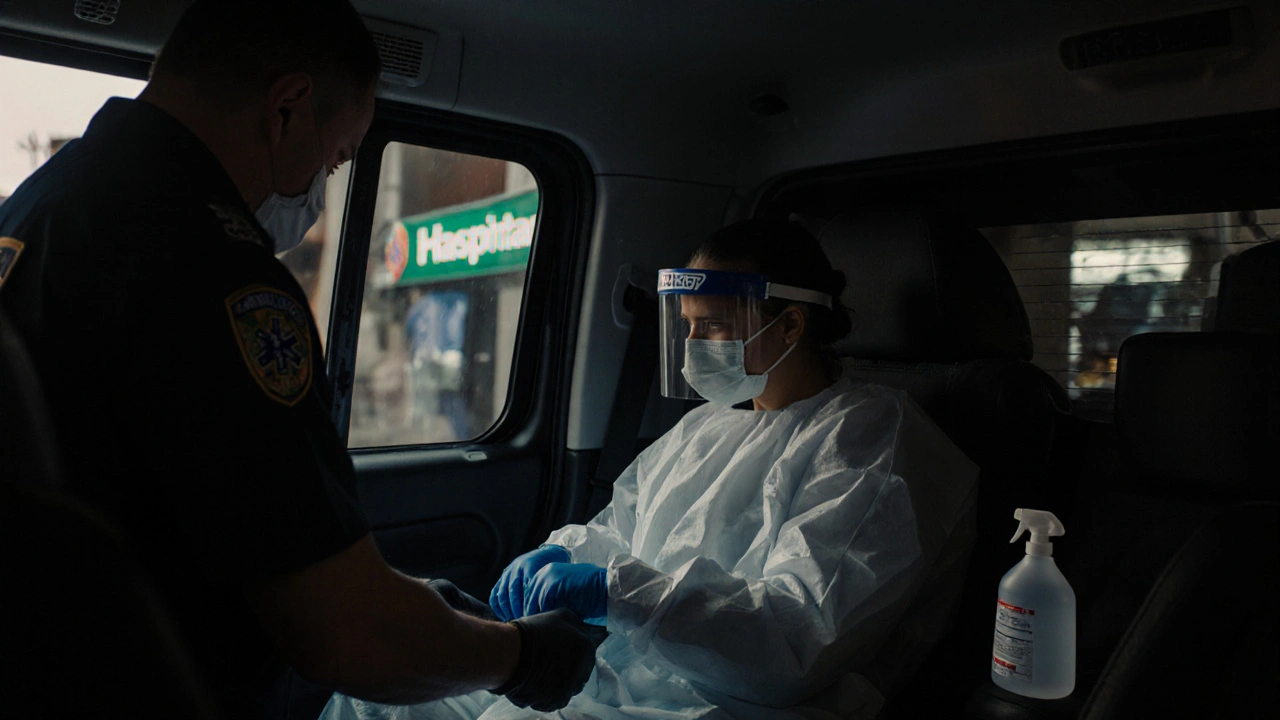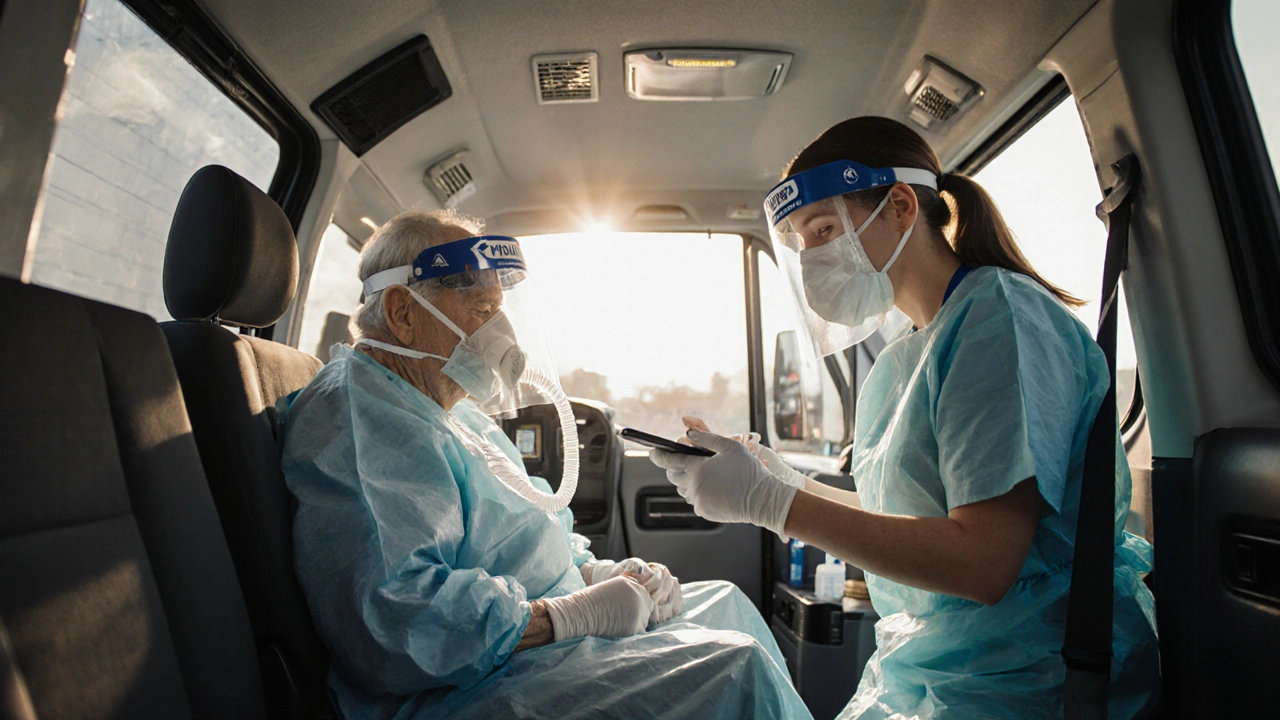When you’re transporting a patient who’s recovering from COVID-19-or even just one who’s vulnerable to it-the stakes aren’t just high. They’re life-or-death. Medical escort services don’t just move people from point A to point B. They keep them alive during transit. That’s why every step, from the moment the patient gets in the vehicle to when they’re handed off at the destination, has to follow strict screening and PPE protocols. There’s no room for guesswork.
Who Needs Medical Escort Services During a Pandemic?
Not every patient needs a medical escort. But some absolutely do. Think about someone who just came out of ICU after a severe case of COVID-19. Or a dialysis patient with compromised immunity. Or an elderly person being transferred between hospitals after testing positive. These aren’t routine trips. They’re high-risk movements.
Medical escort services step in when standard ambulances aren’t enough. These aren’t just drivers. They’re trained medical support staff-paramedics, nurses, or certified transport aides-who can monitor vitals, manage oxygen, adjust medications, and respond to sudden changes. And during a pandemic, they’re also the first line of defense against spreading infection.
Pre-Transport Screening: The First Line of Defense
Before the vehicle even leaves the garage, screening starts. It’s not optional. It’s non-negotiable.
Every patient must be assessed 24 hours before transport. That means checking for fever (above 37.8°C), new cough, shortness of breath, loss of taste or smell, and fatigue. If any of these are present, the trip gets delayed until the patient tests negative or clears medical review.
Patients are asked to self-report symptoms and recent exposure. No exceptions. If they’ve been in contact with someone who tested positive in the last five days, the escort team needs to know. That’s not just protocol-it’s legal under Australia’s Public Health Act 2016.
And it’s not just the patient. Everyone involved gets screened. Drivers, nurses, dispatchers-they all fill out a daily health checklist. No fever. No cough. No recent positive test. If they answer ‘yes’ to any of it, they’re off duty until cleared by a medical officer. No exceptions.
PPE Protocols: What You Wear Matters More Than You Think
PPE isn’t just a buzzword. It’s armor. And for medical escort teams, it’s the difference between going home at night or ending up in isolation.
The standard PPE kit includes:
- N95 respirators or equivalent (not surgical masks)
- Fluid-resistant gowns
- Eye protection (goggles or face shields)
- Disposable gloves (double-gloving recommended)
- Boot covers or shoe disinfectant sprays
Here’s what you don’t do: reuse N95s unless absolutely necessary and only if they’re stored properly in a clean, dry paper bag for at least five days. Studies from the CDC in 2023 showed that N95s can retain infectious particles for up to 72 hours on surfaces. Reuse without proper decontamination is a gamble no team should take.
Donning and doffing matters just as much as wearing. There’s a strict sequence: gloves first, then gown, then mask, then eye protection. Removal? Exactly the reverse. One wrong move-touching your face before washing hands-can undo everything.
Teams in Perth have adopted a buddy system. One person watches the other remove PPE. If someone touches their mask or face during removal, they stop. They reset. They retrain. It’s awkward. It’s slow. But it saves lives.

Vehicle Disinfection: The Mobile Clinic That Must Stay Clean
The transport vehicle isn’t just a car or van. It’s a mobile isolation unit. And it needs to be sterilized after every single trip.
After each patient, the interior gets wiped down with EPA-approved disinfectants-specifically those effective against SARS-CoV-2. High-touch areas get extra attention: door handles, seatbelts, oxygen knobs, call buttons, armrests, and the driver’s steering wheel.
HEPA filters are mandatory in all vehicles used for COVID-19 transport. These aren’t fancy upgrades-they’re required by the Australian Health Protection Principal Committee (AHPPC) guidelines. They remove 99.97% of airborne particles, including virus-laden droplets. Without them, the air inside becomes a risk zone.
Windows stay open when weather permits. Even in winter. Airflow reduces concentration of viral particles. No recirculated air. Ever.
And here’s something most people don’t think about: the ambulance stretcher. It’s not just wiped down. It’s covered with disposable, fluid-resistant sheets that get thrown out after every use. No exceptions.
Communication and Handoff: No Room for Error
When the patient arrives at the hospital, clinic, or care facility, the handoff isn’t a quick wave and a thank-you. It’s a formal, documented transfer.
The escort team gives a verbal report to the receiving nurse or clinician. It includes:
- Current vital signs
- Medications administered en route
- Any symptoms that developed during transit
- Time of last oxygen adjustment
- Whether the patient was coughing, confused, or unstable
This report is also written down and signed off by both parties. Paper or digital-it doesn’t matter. But it must exist. If something goes wrong after the handoff, this record is the only thing that protects the escort team and ensures continuity of care.
And the receiving facility? They’re required to have a designated isolation area ready. No patient walks straight into a waiting room. No exceptions.

Training and Compliance: It’s Not Just About Rules
Every medical escort provider must have a documented infection control plan. And every staff member must be trained on it-quarterly, no exceptions.
Training isn’t a PowerPoint slide deck. It’s hands-on. It’s mock scenarios. It’s role-playing a patient who suddenly vomits mid-transport. It’s practicing PPE removal under time pressure. It’s learning how to calm a scared patient while wearing a mask that muffles your voice.
Compliance isn’t checked once a year. It’s audited monthly. Random spot checks. Video reviews. Feedback from hospitals. If a team misses a step-even once-they’re pulled aside. Retrained. Re-tested.
And here’s the truth: most outbreaks linked to medical transport didn’t happen because of bad equipment. They happened because someone skipped a step. Forgot to change gloves. Didn’t disinfect the door handle. Thought, “It’s just a quick trip.” That’s all it takes.
What Happens When Protocols Break Down?
It’s not hypothetical. In 2023, a private medical transport service in Adelaide had a cluster of infections after a driver reused an N95 mask for three days. Five patients and two staff tested positive. The company lost its license for six months. Insurance premiums tripled. Staff quit.
That’s not an outlier. It’s a warning. When protocols slip, the consequences aren’t just financial. They’re human.
One nurse in Melbourne told me: "I used to think I was just driving people around. Then I realized-I’m the last thing standing between them and another infection. That’s not a job. That’s a responsibility."
Final Thoughts: It’s Not Just About Compliance
Following screening and PPE protocols isn’t about ticking boxes. It’s about trust. The patient trusts you to keep them safe. The hospital trusts you not to bring the virus in. The public trusts that medical transport won’t become a vector for spread.
There’s no app that automates this. No shortcut. No cost-cutting hack that doesn’t put lives at risk. Every glove changed, every surface wiped, every question asked-it adds up. And in the end, that’s what keeps people alive.
Do medical escort services need to follow the same PPE rules as hospitals?
Yes. In Australia, medical escort services are classified as high-risk healthcare transport under the National Health and Medical Research Council (NHMRC) guidelines. They must meet or exceed the same PPE standards as hospitals and clinics. This includes using N95 respirators, gowns, and eye protection during patient transport, especially for suspected or confirmed COVID-19 cases.
Can a medical escort service refuse to transport a patient who refuses to be screened?
Absolutely. Under Australian public health law, transport providers have the right-and the legal duty-to refuse service if a patient declines screening or refuses to wear a mask. This isn’t discrimination; it’s infection control. Transporting an unscreened, potentially infectious patient puts the crew, other patients, and the public at risk. Most services have a written policy that outlines this, and staff are trained to handle these situations calmly and professionally.
How often should PPE be replaced during a long transport?
Gloves must be changed after any contact with bodily fluids, after touching contaminated surfaces, or if they tear. If a transport lasts longer than two hours, it’s standard practice to replace gloves and sanitize hands at least once. N95 masks should not be worn for more than eight hours total, even if they look clean. If the mask becomes damp, soiled, or hard to breathe through, it’s replaced immediately-no waiting.
Are HEPA filters required in all medical escort vehicles?
Yes, according to the Australian Health Protection Principal Committee (AHPPC), all vehicles used for transporting patients with suspected or confirmed respiratory infections like COVID-19 must be equipped with HEPA filtration systems. These filters remove airborne particles as small as 0.3 microns with 99.97% efficiency. Standard cabin filters are not sufficient. This requirement applies to all private and public medical transport services operating in Australia.
What happens if a medical escort worker tests positive for COVID-19?
They are immediately removed from duty and must isolate for at least seven days, following current Australian health guidelines. The service must notify all patients transported in the 48 hours before symptom onset or positive test. Contact tracing is conducted internally and reported to local public health authorities. Staff are required to get tested before returning to work, even if asymptomatic. Many services now require weekly rapid antigen tests for all frontline workers as a precaution.
